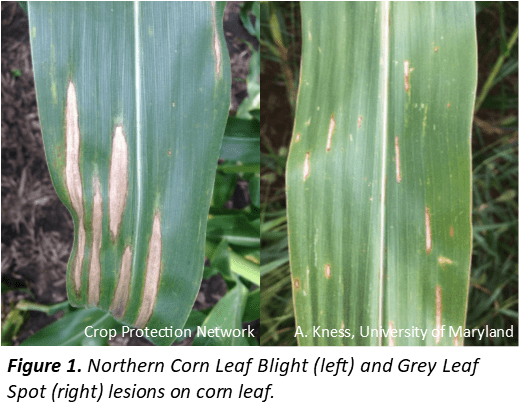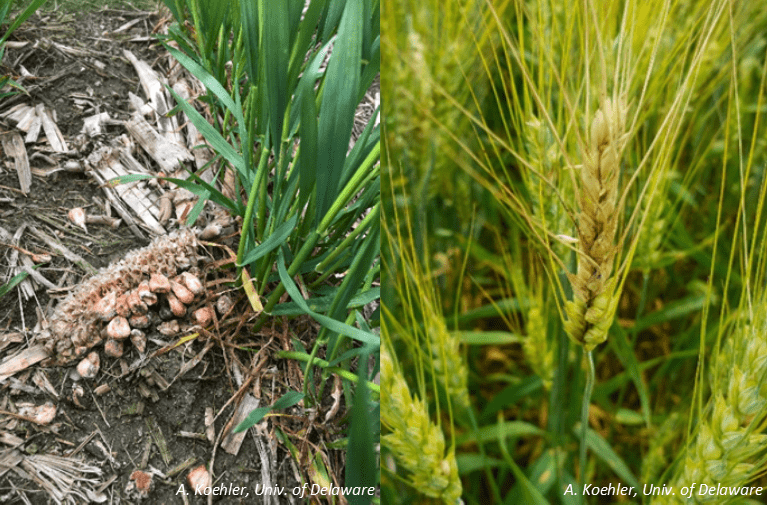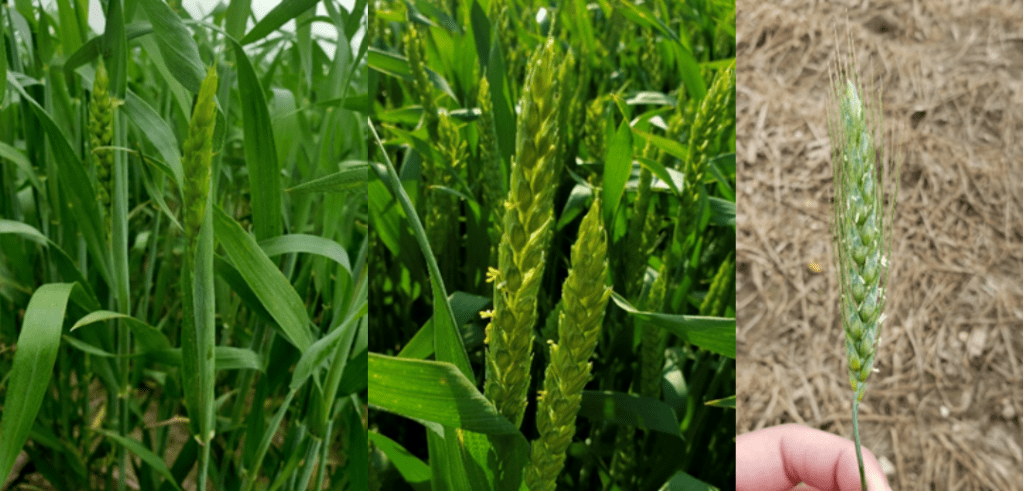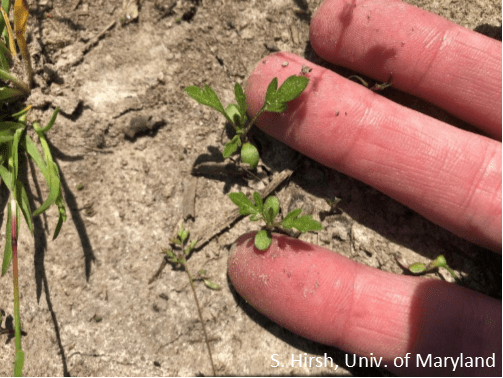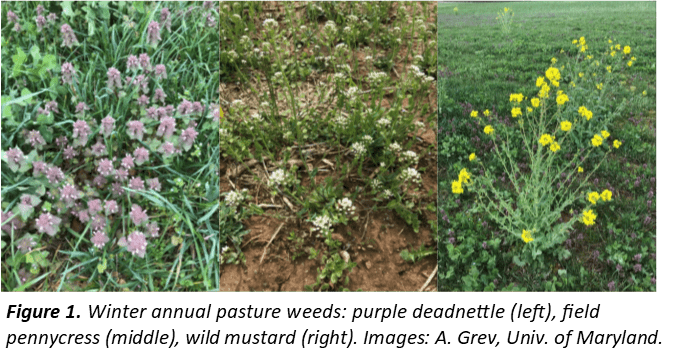Kelly Hamby, Terry Patton, and Galen Dively
Department of Entomology, University of Maryland College Park
Summary. Weather stations in Baltimore, MD recorded the 3rd warmest winter on record in 81 years from Dec 2019 to February 2020, with 10% of our 30 year average snowfall (NOAA National Climate Report). Insects that overwinter as immatures or adults in above-ground protected areas are typically favored by mild winters, especially species that are not cold-hardy because much of the population would typically die during the winter. However, the lack of snowfall can also reduce overwintering survival because snow can insulate against freezing temperatures. Mild winter conditions favor green bug aphids and winter grain mite outbreaks in small grains and orchardgrass, and these pest populations can build rapidly. Fortunately, mild winters also favor many beneficial natural enemies. Greenbug aphid outbreaks have been observed in central Maryland orchardgrass (see Figure 1), and greenbugs have also been observed in Delaware. Overall, aphid populations have been spotty in Delaware and promising natural enemy activity has been observed (UD Weekly Crop Update, March 20). However, close surveillance is necessary when greenbug is the predominate species because greenbug injects toxic saliva during feeding and can be very destructive. It is important to carefully scout your fields for aphids multiple times to determine whether populations are building or crashing on your farm. Management interventions may be necessary to prevent economic losses. Winter grain mites may also be a problem this year and scouting close to the soil surface is necessary to catch this issue in a timely manner.
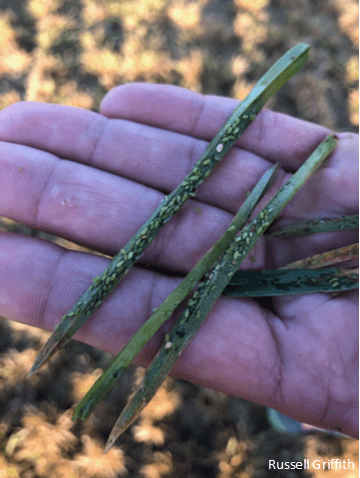
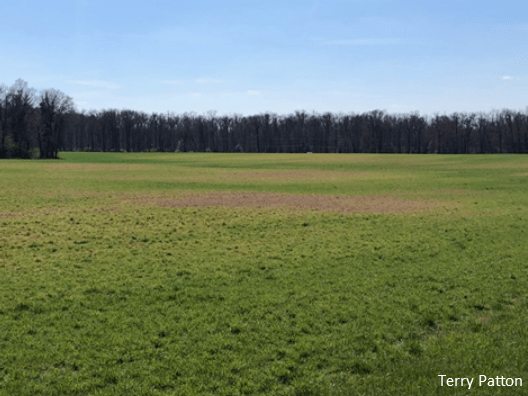
Cereal Aphids and Greenbugs. Multiple species of aphid occur in Maryland small grains and orchardgrass (see Figure 2) and aphids can vector barley yellow dwarf virus. Bird-cherry oat aphids vector the most severe strain and may need to be managed in the fall to prevent damage from barley yellow dwarf, especially in intensive management wheat. Although the direct damage from aphid feeding is generally similar across species, it is especially important to record species if greenbugs are present. Greenbug saliva contains enzymes that break down cell walls, so their feeding is most damaging. They initially cause spotting on the leaf followed by discoloration and eventual leaf and root death if feeding continues. Grain cultivars vary in their tolerance for greenbug damage. One of the first noticeable symptoms of aphid outbreaks are circular yellow to brown spots with dead plants in the center (see Figure 3); however, aphid damage may be confused with moisture stress and/or nitrogen deficiency so make sure to scout for aphids especially in areas that are showing stress symptoms. Scout a minimum of 1 linear row foot in 10 sites, the more row feet and locations the better, and estimate the number of aphids per foot of row. The rule of thumb treatment threshold for small grains is to treat if counts exceed 150 per linear foot throughout most of the field, with few natural enemies detected (e.g., mummy aphids, lady beetles, fungal infections). One natural enemy to every 50 to 100 aphids can be enough to control the population. This threshold may be lower if greenbugs are the predominant aphid and greenbug populations should be carefully monitored. Foliar insecticides including pyrethroids (Group 3A), neonicotinoids (Group 4A), and organophosphates (Group 1B) can be used to control aphids.
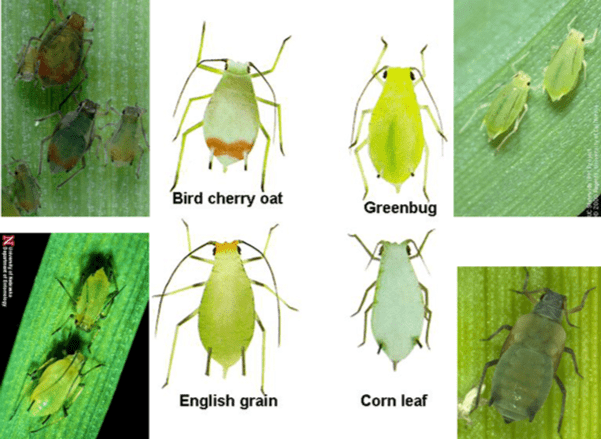
Winter Grain Mite. Winter grain mites are a cool season pest of small grains and orchardgrass that cause a silvery leaf discoloration from feeding damage that punctures individual plant cells. Feeding can also stunt plants. Winter mites have a dark brown to black body with bright reddish-orange legs (see Figure 4). Somewhat uniquely, their anal opening is on the upper surface and can appear as a tan to orange spot that is more visible under magnification. Two generations of winter grain mite occur per year and are active from the fall to early summer. They oversummer in the egg stage, with the first generation hatching around October and adult populations peaking in December or January. The second generation peaks from March to April and produces the oversummering eggs. Because spring eggs result in fall populations, rotating the crop away from grasses and managing wild grasses around field edges can be helpful to reduce populations. Adult activity occurs when temperatures are between 40 and 75°F, and they prefer cool, cloudy calm weather. Therefore, winter grain mites are easier to see during these conditions, and more likely to be higher on the plant during the early morning or late evening. If you are scouting on a hot, dry day or in the middle of the day, you should check under residue where the soil is moist, and may need to dig 4 or 5 inches into the soil to find the mites. Winter grain mite does not typically cause economic damage, and no thresholds have been developed. If large portions of a field show symptoms and mites are present, treatment may be warranted. No products are specifically labeled for winter grain mite; however, products labeled for brown mite such as dimethoate (Group 1B, in wheat only) are likely to be effective. Warrior II (pyrethroid, Group 3A) may also provide suppression.

References and Useful Extension Articles:
Kansas State University Wheat Pests, Winter Grain Mite, https://entomology.k-state.edu/extension/insect-information/crop-pests/wheat/winter-grain-mite.html
NOAA National Climate Report Supplemental Material, https://www.ncdc.noaa.gov/sotc/national/202002/
Oklahoma State World of Wheat Blog, Winter grain mites in northcentral OK, https://osuwheat.com/2015/01/06/winter-grain-mites-in-northcentral-ok/
University of Delaware Weekly Crop Update March 20,2020. Agronomic Crop Insect Scouting, https://sites.udel.edu/weeklycropupdate/?p=14510
University of Delaware Fact Sheets and Publications, Winter Grain Mite Management in Small Grains, https://www.udel.edu/academics/colleges/canr/cooperative-extension/fact-sheets/winter-grain-mite/
Virginia Tech Insect Control in Field Crops, ENTO-335C, https://www.pubs.ext.vt.edu/content/dam/pubs_ext_vt_edu/456/456-016/ENTO-335C.pdf
